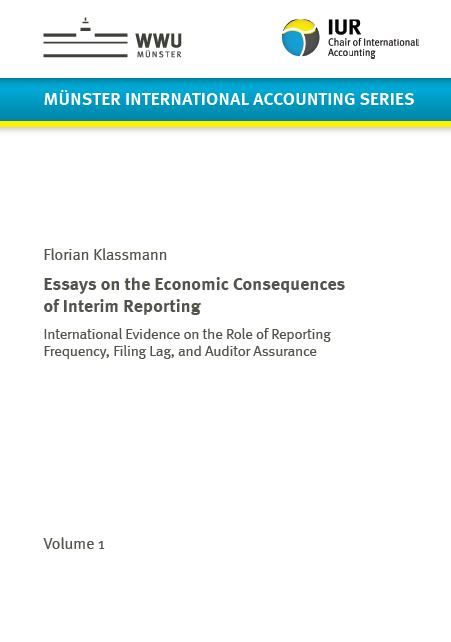Volume 1 - Florian Klassmann
Essays on the Economic Consequences of Interim Reporting
International Evidence on the Role of Reporting Frequency, Filing Lag, and Auditor Assurance

Interim reports provide investors with timely information about firms’ operations within the financial year. For many decades, academics and practitioners around the world have been discussing how interim reports can achieve this objective at best. This thesis covers three aspects of interim reporting regulation that are central to this discussion: reporting frequency (study 1), filing deadlines (study 2), and the role of auditors in the assurance of interim reports (study 3).
The first study, „The Effect of Mandatory Quarterly Reporting on Firm Value and Liquidity: Evidence from a Quasi-Natural Experiment in Singapore“, analyzes the capital market effects of mandatory quarterly reporting in Singapore. Firms with a market capitalization above S$75 million had to switch from half-yearly to quarterly reporting starting in 2003. Using regression discontinuity analysis, the study shows that smaller firms that did not have to adopt quarterly reporting experienced a significant short-term increase in firm value. In addition, the study does not find improvements in liquidity for firms around the threshold of S$75 million that start to report quarterly. Thereby, the results indicate that quarterly reporting may yield no informational benefits for smaller firms.
The second study, „The Implications of Filing Deadlines for Quarterly Reporting“, explores the effect of shorter filing deadlines on the quality and information content of quarterly reports. The study exploits a regulatory change in the US, which accelerated quarterly filing deadlines for firms with a public float of more than $75 million from 45 to 40 days. Using difference-in-differences analysis, the study does not find evidence of a decline in reporting quality because of higher time pressure. However, in line with the regulation’s objective to improve the relevance of quarterly reports, the study documents higher market reactions to interim reports that are filed in a timelier manner.
The third study, “Do Reviews by External Auditors Improve the Information Content of Interim Financial Statements?“, analyzes whether interim financial statements that were reviewed by an external auditor have more information content than interim financial reports without an external review. The study uses a sample of Prime Standard listed firms in Germany for which reviews of interim financial statements were voluntary during the sample period (2006-2011). The study finds that market reactions to the disclosure of reviewed interim financial statements are substantially higher than those to the disclosure of un-reviewed financial statements. Moreover, the study finds no evidence that reporting quality is better when an external auditor reviewed the interim report. Hence, market reactions to reviewed financial statements seem to be driven by a signaling effect rather than an increase in assurance value.
Taken together, the three individual studies inform regulators, firms, and users of interim financial reports about the consequences of different interim reporting regulations. Thereby, this thesis provides insights on how interim reports can effectively contribute to the capital market communication.


